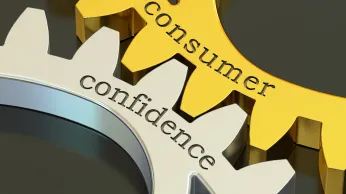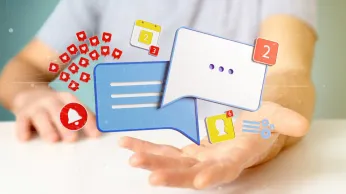كيفية بناء استراتيجية إشراك العملاء على مدار العام
استراتيجية مشاركة العميل هي المفتاح لبناء قاعدة عملاء قوية تثق في عملك وتحول. اقرأ هذا الدليل حول بناء استراتيجية على مدار العام.
في هذه الصفحة
الحفاظ على ولاء العملاء وتفاعلهم هو مفتاح نجاح أي شركة على المدى الطويل. وهذا صحيح بشكل خاص لأن العلاقات القوية مع العملاء قد تؤدي إلى زيادة ولاء العملاء، وتكرار الأعمال التجارية، والدعوة الإيجابية للعلامة التجارية. كما أن المشاركة المستمرة تُظهر للعملاء أنك ملتزم تجاههم، مما يؤدي إلى بناء الثقة وتعزيز النمو.
ومع ذلك، مع وجود منافسين يقدمون بدائل مغرية وشركات مختلفة تتنافس على جذب الانتباه، قد يكون من الصعب أن تبرز وتبتكر تجربة ناجحة لعملائك.
تابع القراءة حيث توضح هذه المقالة استراتيجية فعالة لمشاركة العملاء على مدار العام من شأنها أن تضع شركتك على رأس قائمة علاقاتها مع العملاء. لنبدأ.
فهم قاعدة عملائك
إن الفهم العميق لعملائك يضع الأساس لاستراتيجية مشاركة مؤثرة. يرغب العملاء في التعامل مع الشركات التي تفهمهم، حيث تُظهر الأرقام أن 66% من العملاء يتوقعون من الشركات فهم احتياجاتهم وتوقعاتهم.
لذا، خذ وقتك في جمع البيانات الكمية والرؤى النوعية التي تتحدث عن احتياجاتهم. استخدم الاستبيانات والمحادثات التي تركز على تحديات العمل وتفضيلات التواصل واهتمامات المحتوى.
ثم تتبع هذه التفاصيل بمرور الوقت ضمن نظام مركزي لإدارة علاقات العملاء. سيكشف تحليلك عن مجموعات فرعية توحدها خصائص وسلوكيات مشتركة أساسية للتواصل المخصص.
بينما هذا هو الحال، قاوم إغراء النظر إلى العملاء كنقاط بيانات. قم بإجراء محادثات حقيقية تبني الألفة والثقة. اطرح أسئلة مدروسة، ثم استمع بنشاط، وسعَ لفهم دوافعهم ودوافعهم الأساسية.
لا يمكنك الكشف عن القصص الإنسانية والشخصيات الحقيقية التي تقف وراء كل عميل إلا بالعناية والنية. هذا التعاطف هو الذي يُعلم الاتصالات التي يكون لها صدى على المستوى الشخصي.
وأخيراً، أبقِ سياق العميل في ذهنك مع كل تفاعل. قم بالإشارة إلى المحادثات والمعالم السابقة عند الاقتضاء لإثبات الألفة.
يمكنك أيضًا نسج الأخبار والرؤى الخاصة بوسائل التواصل الاجتماعي لعرض فهمك لعالمهم. الارتباط المستمر بالشخص الكامل وراء الأعمال التجارية يبني اتصالات ذات مغزى التي تترجم إلى مشاركة.
التواصل المخصص
يتم تجاهل الرسائل العامة وغير الشخصية بسهولة في مشهد اليوم المزدحم. لذا، اخترق الضوضاء من خلال التفاعلات الشخصية التي تلبي احتياجات الأفراد، وليس المؤسسات. احتفظ أيضًا ببيانات العملاء المنظمة لتقسيم الجماهير وتخصيص الأساليب.
عند إرسال رسائل البريد الإلكتروني، اجعلها مستهدفة قدر الإمكان من خلال سطور موضوع مخصصة، وعروض مرتبطة باحتياجاتهم، وتوصيات المحتوى بناءً على اهتماماتهم. تجدر الإشارة إلى أنه في مجال التسويق عبر البريد الإلكتروني اليوم، فقط 20%-40% فقط من رسائل البريد الإلكتروني يتم فتحها من قبل المستلمين. لذلك، أوصل دورتك بأفضل شكل ممكن.
لا تعتمد فقط على التواصل الرقمي من مسافة بعيدة أيضاً. استكمل التكنولوجيا بلحظات إنسانية صادقة تفاجئك وتسعدك. على سبيل المثال، قم بكتابة رسائل تهنئة بخط اليد تقديراً للترقيات أو الشراكات الجديدة. يمكنك أيضًا التفكير في التواصل وجهًا لوجه على فنجان قهوة غير رسمي عندما يكون ذلك ممكنًا أو تسجيل رسالة فيديو سريعة للاطمئنان بعد مؤتمر صناعي كبير. تُظهر هذه اللمسات الشخصية المدروسة والمخصصة اهتماماً حقيقياً بالعلاقة يتجاوز المعاملات.
أخيراً، راقب اللحظات ذات الصلة التي تستحق الذكر عبر قنوات التواصل.
يساعد تقديم القيمة بشكل استباقي على بناء حسن النية والثقة التي تعزز المشاركة.
إهداء الشركات: نهج على مدار العام
تُعد هدايا الأعياد من أساسيات العلاقات مع العملاء اليوم. ولكن بينما تركز العديد من الشركات على تقديم الهدايا خلال العطلات، فإن توسيع نطاق هذا النهج على مدار العام يمكن أن يكون له تأثير أكبر.
ومع ذلك، قم بتعيين تذكيرات في التقويم لأعياد الميلاد الفردية والأحداث الهامة للشركة. يمكنك أيضًا الاستفادة من العطلات الفريدة، مثل يوم تقدير العملاء في أبريل، لتمييز عملك عن غيره وإقامة اتصالات أعمق مع عملائك.
Besides the timing, the gift items are equally important. Gifts demonstrating thoughtfulness foster emotional connections and memorable impressions. So, select items aligned with your brand identity and their interests to reinforce positive associations.
من المفيد أيضاً إنشاء قائمة بالاهتمامات والتفضيلات التي تم جمعها من المحادثات والاستطلاعات لإثارة أفكار هدايا مصممة خصيصاً عند الاقتضاء. يمكنك أيضاً إضافة لمسات شخصية مثل التخصيص والملاحظات المكتوبة بخط اليد.
والأهم من ذلك، تنفيذ تجربة الإهداء الكاملة بعناية وأصالة. تجنب الالتزام بالمعاملات - أسعد عملاءك كأشخاص وليس كعملاء.
يمكن للحظات التقدير غير المتوقعة وذات المغزى في نفس الوقت أن يكون لها مفعول السحر. فالهدايا المدروسة من دون سابق إنذار تجعل الناس يشعرون بأنهم مميزون حقًا، مما يعمق العلاقات والولاء.
1. استضافة الفعاليات والمشاركة فيها
تسهل فعاليات الصناعة تبادل الخبرات المشتركة والتواصل بين الأقران حول الاهتمامات المشتركة. إنها ليست مجرد وسيلة للاستمتاع، ولكنها تمنح عملك فرصة للتواصل مع العملاء شخصيًا، وبيع القيمة وجهًا لوجه، و زيادة التحويلات.
خصص الموارد اللازمة لتنظيم أفضل الفعاليات المستضافة في فئتها، مع تقديم قيمة حقيقية للحضور. خطط بعناية للجداول الزمنية، واختر الأماكن، ورتّب المتحدثين، واختر خدمات تقديم الطعام مع وضع تجربة العميل في الاعتبار. ثم قم بالمتابعة من خلال استطلاعات الرأي والاستماع الاجتماعي والمحادثات للمساعدة في تحسين الفعاليات المستقبلية باستمرار.
على الصعيد الخارجي، اتبع نهجًا مستهدفًا في فعاليات الصناعة الخارجية. ضع أهدافاً واضحة قبل الحضور تتمحور حول بناء العلاقات أو توليد العملاء المحتملين أو أبحاث السوق. من المفيد أيضاً إنشاء قائمة بالاتصالات الرئيسية القائمة والآفاق الواعدة أو الشركاء الواعدين للتواصل معهم. أخيرًا، تعامل مع المحادثات باهتمام حقيقي، واستمع بفاعلية لفهم التحديات وتحديد الفرص المتاحة لتقديم قيمة.
تذكّر أن الحدث يشعل الشرارة الأولى، بينما تحافظ الرعاية اللاحقة للحدث على استمرار النار. لذا، اجمع بطاقات العمل ودوّن ملاحظات شاملة، واجمع التفاصيل لإثراء عمليات المتابعة الشخصية.
عندما تتواصل، قم بالإشارة إلى موضوع نقاش محدد أو جهة اتصال جديدة لتعزيز الذكريات المشتركة. بمرور الوقت، تتراكم نقاط التواصل ذات المغزى هذه، مما يعزز الروابط من خلال التفاعلات الإيجابية المتكررة.
2. استخدام التكنولوجيا من أجل المشاركة
توفر حزم تكنولوجيا التسويق الحديثة العديد من الأدوات لتعزيز مشاركة العملاء. على سبيل المثال، يمكنك جعل البيانات مركزية داخل منصات إدارة علاقات العملاء لإبلاغ التفاعلات الشخصية المستندة إلى السياق التاريخي. كما يمكنك أيضاً استخدام أتمتة التسويق لتوسيع نطاق التواصل الفردي عبر القنوات الرقمية المصممة خصيصاً حسب الاهتمامات والسلوكيات.
ومع ذلك، لا يمكن للخوارزمية أن تحاكي الفوارق الدقيقة بين البشر إلا جزئياً. قم بوضع قواعد تكتيكية وحواجز حماية حتى تحافظ الرسائل التي تعتمد على التكنولوجيا على نبرة أصيلة. من الجيد أيضًا إنشاء فرق مخصصة من المتخصصين لتنفيذ حملات دورة الحياة التي توازن بين التخصيص والإنسانية.
وعلاوة على ذلك، راقب بيانات الأداء، ورؤى الاستماع الاجتماعي، وتعليقات العملاء لقياس الصدى العاطفي.
يجب أن تمكّن التكنولوجيا من التواصل الصادق لا أن تحل محلها. لذلك، قم بتوفير إمكانية الوصول السريع إلى ممثلين حقيقيين عبر الدردشة عبر الإنترنت ونماذج الاتصال عند الحاجة إلى إجراء محادثات عالية اللمسة وتوجيه المستخدمين إلى المتخصصين المناسبين بناءً على احتياجاتهم الفريدة.
كما أن الاستثمار في التدريب على التعاطف والوصول إلى المعلومات حتى تتمكن فرق العمل من تقديم تجارب مخصصة تتماشى مع الرؤى القائمة على التكنولوجيا يقطع شوطاً طويلاً. تظل اللمسة الإنسانية أمرًا بالغ الأهمية، حتى في عالم مؤتمت.
3. التماس التعليقات من أجل التحسين المستمر
تتطلب دورة حياة استراتيجية مشاركة العميل الالتزام بالاستماع والتعلم والتحسين المستمر. يبدأ بناء الثقة بالاعتراف بكل تواضع بأنك لا تملك جميع الإجابات اليوم ولكنك تسعى بنشاط للحصول عليها.
لفهم عملائك بشكل أفضل، احصل على ملاحظاتهم عبر مبادرات مثل الفعاليات وحملات الإهداء والاتصالات المنتظمة.
أنشئ أسئلة استقصائية ترصد جوانب مختلفة من رحلة العميل معك. ضع في اعتبارك استخدام مزيج من الأسئلة المفتوحة والمغلقة التي تسمح للعملاء بالتعبير عن أنفسهم. وعلاوة على ذلك، اطرح أسئلة محددة ومدروسة في نفس الوقت لتشجيع الردود الصريحة.
قم بتطبيق كل من التحليلات الكمية والنوعية لتحديد نقاط الاحتكاك والفرص المتاحة. يمكنك أيضًا إلقاء نظرة على معدلات المشاركة في الفعاليات ومقاييس استرداد الهدايا، وكذلك قراءة التعليقات الحرفية عن كثب.
علاوة على ذلك، قم بتحديد المواضيع الرئيسية مع إيلاء اهتمام مماثل للمشاعر العاطفية.
يوصى أيضًا بإجراء لقاءات منتظمة مع اللجان الاستشارية للعملاء لمناقشة الاتجاهات التي تشكل الصناعة والآثار المحتملة وطرح الأفكار أو التعاون في مبادرات جديدة تضيف قيمة.
شارك في إنشاء مستقبل علاقتك المشتركة، وفي النهاية نجاحها. تحافظ عقلية الإصغاء والنهج المرن على مواءمة استراتيجيات المشاركة مع الاحتياجات المتطورة.
دراسات حالة عن ارتباطات العملاء
لقد تفوقت العديد من الشركات في استراتيجيات إشراك العملاء من خلال الإهداء والفعاليات والتكنولوجيا للتواصل مع العملاء بشكل أفضل. إليك نظرة على الاستراتيجيات التي طبقتها HubSpot و Zappos:
1. مؤتمر HubSpot's Inbound Conference
تقدم HubSpot مشاركة استثنائية للعملاء من خلال الفعاليات. على سبيل المثال، يوفر مؤتمرهم السنوي INBOUND فرصاً للتعلم، بما في ذلك الكلمات الرئيسية والجلسات الفرعية وورش العمل التي يقودها قادة الصناعة. يتسنى للحاضرين التواصل بشأن التحديات والاهتمامات المشتركة خلال فعاليات التواصل المخصصة.
تعمل هذه التجارب الجماعية على توحيد المشاركين حول مجتمع HubSpot المركزي، مما يعزز الروابط، خاصة بين العملاء الحاليين. ومن خلال التركيز على القيمة والاتصال والتحسين المستمر، تستفيد HubSpot من فعاليتها الرئيسية لتعميق الولاء.
2. شحن زابوس والهدايا المفاجئة
بنى متجر التجزئة عبر الإنترنت Zappos تفانيه من خلال خدمة العملاء الممتازة. فهم يؤكدون على إبهار المستهلكين باستمرار في جميع نقاط التواصل التي تتجاوز المعاملات الأساسية.
تساعد مثل هذه التجارب الهادفة في تشكيل المشاعر الإيجابية، وتشكيل ذكريات ممتعة مرتبطة بعلامة Zappos التجارية. وتنتقل هذه المشاعر إلى الخارج في شكل إحالات متحمسة، مما يؤدي إلى نمو مستدام من خلال الكلام الشفهي. ومن ثم يعزز التأثير الجماعي الولاء والتأييد.
الوجبات الجاهزة الرئيسية
لا تقتصر استراتيجية إشراك العملاء الفعالة على العروض أو المبادرات الموسمية فحسب، بل تتطلب نهجًا متسقًا لفهم عملائك وتعزيز الروابط الحقيقية معهم.
إذاً، كيف تفعل ذلك؟ تخلص من الرسائل العامة وغير الشخصية، واعتمد الإهداء خلال اللحظات المهملة على مدار العام، وشارك في فعاليات الصناعة لمقابلة العملاء شخصياً. التكنولوجيا هي حليفك أيضاً. استفد منها لتعزيز مشاركة العملاء.
بشكل أساسي، امنح عملاءك تجربة رابحة. والنتيجة؟ أنت تبني ثقة العملاء وولاءهم، وتعزز سمعة علامتك التجارية، وتحافظ على نمو أعمالك!










